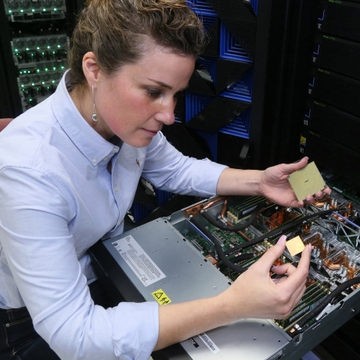Known to Boston-area commuters as the “T,” the Massachusetts Bay Transportation Authority (MBTA) operates most public transit services in the greater Boston area, and is one of the largest public transit systems in the United States. Founded in 1964, its trains still run through the country’s first subway tunnels—but the T’s technology has come a long way.
The MBTA’s customer technology department manages rider-facing solutions like the agency’s website and countdown signs on train platforms. To promote agility and rapid decision-making, the department’s leaders adopted Slack, the secure channel-based messaging platform, in 2016.
The team quickly became reliant on Slack channels, a single place to collaborate and communicate. With a carefully organized system of channels, team members could:
- Share ideas about services across teams and projects to improve the rider experience
- Gather data across systems to build richer solutions for employees and riders
- Respond to, communicate about and solve incidents faster
When it comes to transit, every minute counts. That’s why the MBTA team was especially pleased they could use Slack to plan solutions for both transit issues, like delayed trains and crowding, and technical problems, like broken countdown screens and app outages.
As the team’s adoption grew beyond the technology department, MBTA employees learned to use the platform in unexpected ways. This gave them the foundation to easily pivot to remote work during the Covid-19 pandemic, ultimately launching an award-winning tool to help commuters safely plan socially distant travel.

“In the time it takes to use email or schedule a meeting, a group of people can gather in Slack to solve the problem.”
Bringing the right teams together to improve every trip
The customer technology department is divided into several teams and functional areas, from managing bus data to overall design and engineering. In addition, they work with staff in many other MBTA departments, from data analysts in the Office of Performance Management to dispatch supervisors in the Operations Control Center. To help these teams share ideas and participate in collaborative projects, the department created a variety of Slack channels:
#website, for flagging and addressing issues with mbta.com#realtime-data, where operations staff can report problems with vehicle tracking#ctd-customer-feedback, where the department triages customer complaints as they arrive
“The most compelling reason to use Slack is to get the right people together to solve a problem,” says Ryan Mahoney, the director of engineering for MBTA’s customer technology department. “In the time it takes to use email or schedule a meeting, a group of people can gather in Slack to solve the problem.”
As the pandemic took hold and many MBTA employees shifted to working from home, Slack channels helped foster a new remote culture and drive Slack’s adoption. Plus, upper-level managers can easily gather information and keep tabs on things like incidents and resolutions.
“Slack provides a way to keep everyone informed about what’s happening,” says Logan Nash, the deputy director of real-time applications for MBTA. “Initially, it was just a tool for our customer technology team. Now we have more and more executives using Slack, as well as operations staff like dispatchers.”
Teaming up with partners to deliver bus arrival times to riders
Government agencies like the MBTA need to be extra cautious about communicating with people outside the organization. Because Slack’s enterprise-grade security standards extend to Slack Connect—Slack’s solution to communicating and collaborating with outside organizations—the agency was confident they could use it to securely work alongside vendors and customers.
Slack Connect opened the door to opportunities with outside partners, empowering the MBTA to offer riders new and better experiences, faster. For example, the customer technology team created the #mbta-swiftly channel to work with Swiftly, the transit data platform, and provide bus arrival predictions to commuters.
“It’s a really successful vendor integration,” Nash says. “We share data with Swiftly about where our buses are, and they tell us when buses will arrive at bus stops, which is very helpful for our riders.”
In #mbta-swiftly, engineers from the MBTA and Swiftly can also troubleshoot issues like data outages.
Collaborating internally and externally to produce award-winning transit options
During unprecedented challenges like the pandemic, Slack gives MBTA the agility to call on multiple teams and partners, then react and pivot accordingly. To help riders who are trying to keep their distance ride safely, the MBTA conducted a digital survey with passengers. Respondents said information about crowded trains and buses would be helpful—if it was paired with real-time arrival predictions.
Armed with this finding, the customer technology team created #realtime-crowding to internally brainstorm next steps. “This was such a big cross-team initiative in Slack, and included our website, digital screens and data teams,” Nash says.
The next step was to collaborate with key third-party application developers, including the team at Transit app, which works in partnership with the MBTA as its endorsed smartphone app. “We created a new channel with the Transit team in Slack Connect to focus on this crowding initiative,” Nash says. This gave the MBTA the ability to efficiently sync with core stakeholders and key players from separate Transit app departments, including designers and engineers.
“Because of the pandemic, being able to iterate quickly with partners like Transit app in Slack Connect is twice as important,” Nash says. “The level of collaboration we achieved would not have been possible in email. We needed to work as fast as we could to ensure our riders felt safe.”
In just three months, this network of teams took the Real-Time Crowding Data Project from an idea to a product that made the MBTA the largest American transit agency to publish real-time crowding information on local buses—and won this year’s LocalSmart Award in the category of “Local IT Innovation of the Year.” Riders can now use the data integration with the Transit app, MBTA’s website and the agency’s digital screens to get around more safely.
Higher productivity and seamless incident management with Slack integrations
For incidents that could affect the MBTA rider experience or safety, the customer technology department relies on the following Slack integrations:
- PagerDuty, to communicate quickly about incidents
- Asana, to plan out a response to incidents
- GitHub, to track rider responses on social media networks
- Google Drive, to store important documents related to incidents
By using these integrations, teams enjoy faster resolution times and more satisfied riders, all while analyzing how to do better next time.

“Having history from a shared Slack channel is important for incident management. We can develop a root cause analysis and create response records for each incident.”
To help inspectors in the field manage canceled trips and monitor bus movement at terminals, the customer technology team built an integration for the agency’s in-house bus dispatching app, Skate. Bus inspectors access the dispatching tool on tablets to see where buses are currently, and where they should be according to schedules.
Through a Slack integration with Drift, bus inspectors submit problems with the Skate tool. From there, engineers in #bus-technology-team can tackle problems informed by real-time inspector feedback.
Whether they’re resolving incident reports, brainstorming new products or communicating more effectively with teams in Slack, the end goal across the MBTA is always to better serve riders.
“The tools and integrations we created to use with Slack don’t just make life easier for us inside the agency,” says Mahoney. “They benefit our riders. If we’re more knowledgeable about the state of our buses and trains, then people have better, safer trips.”















